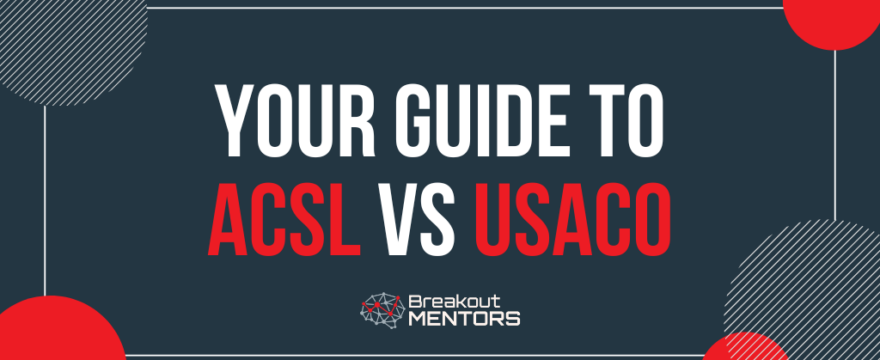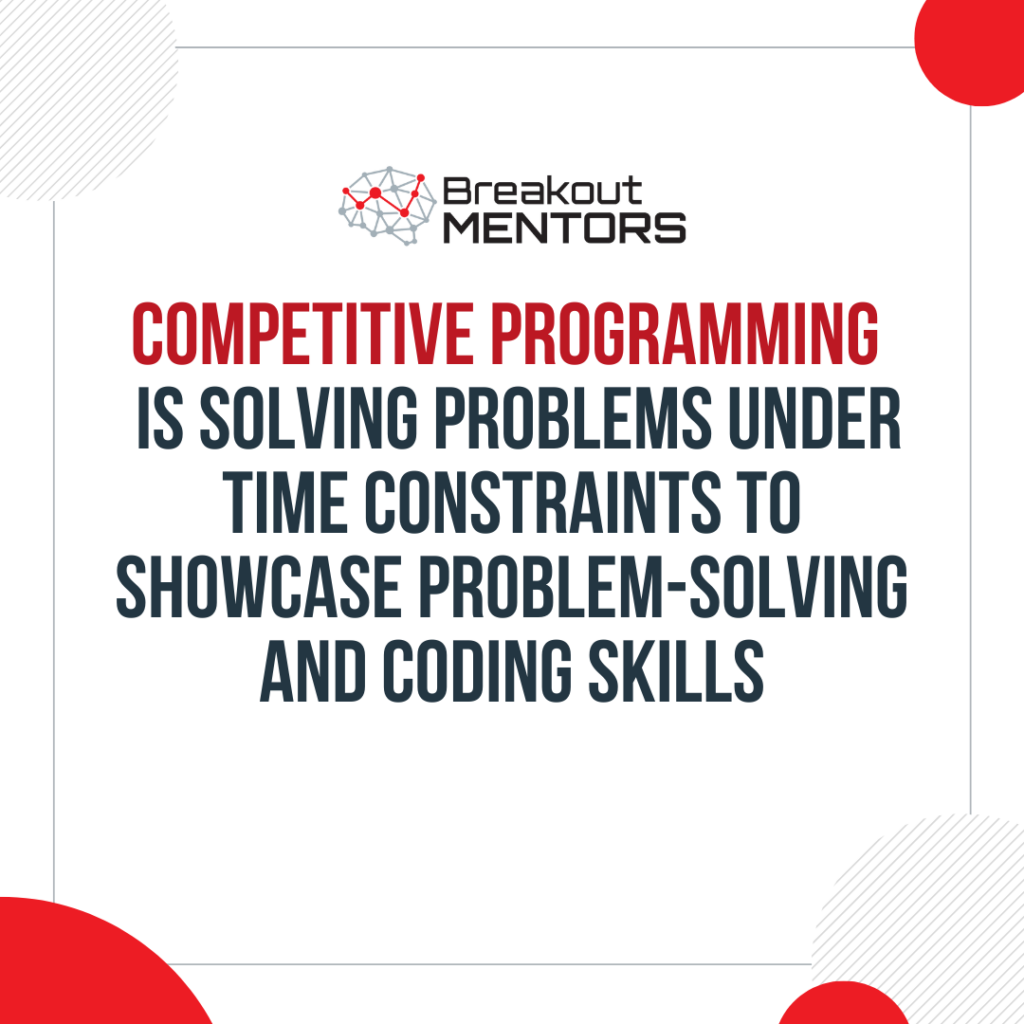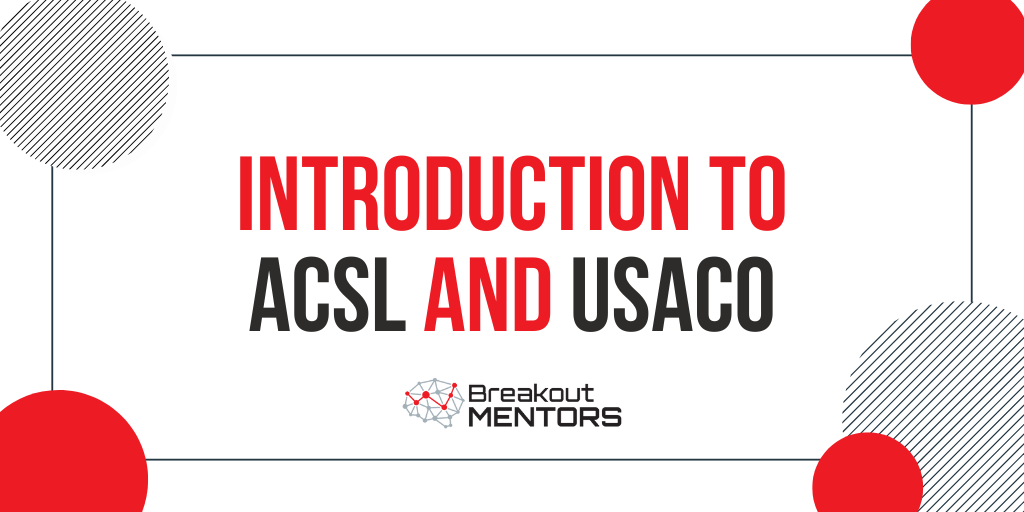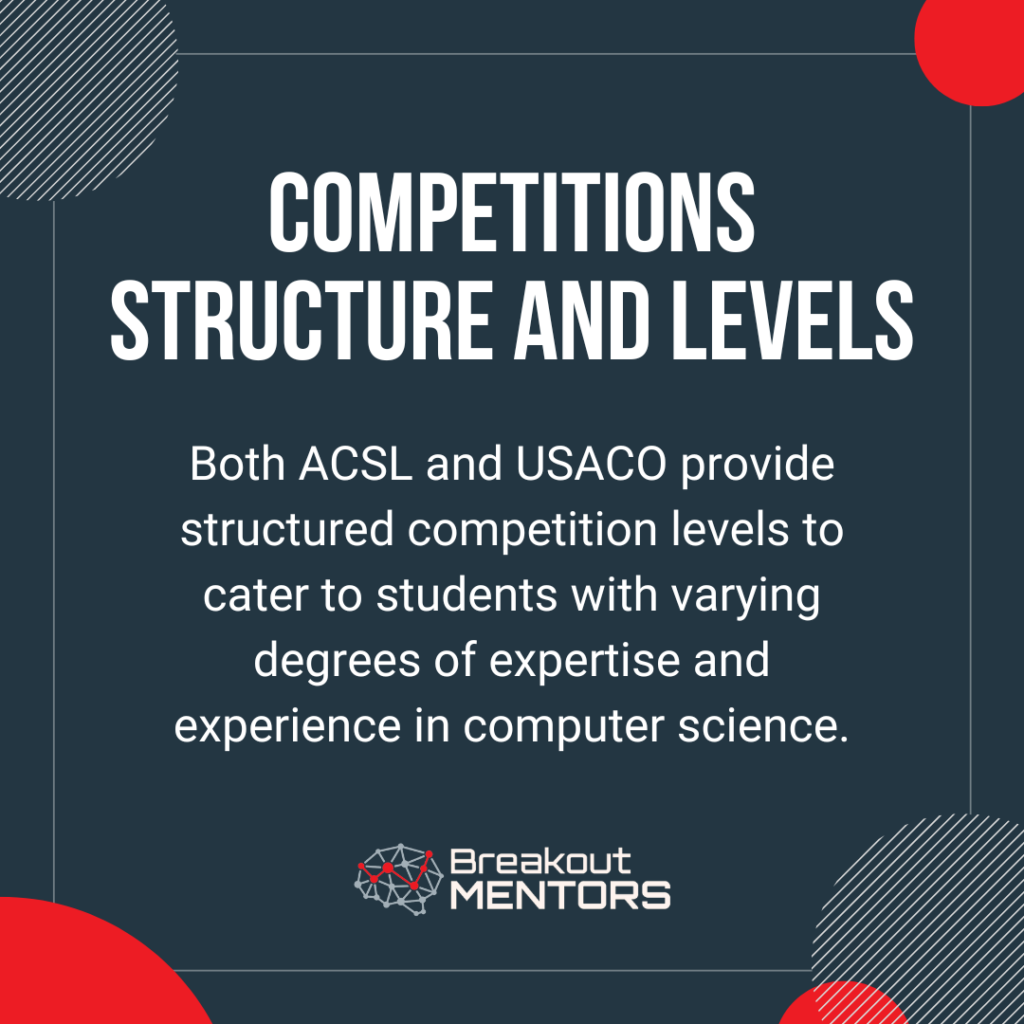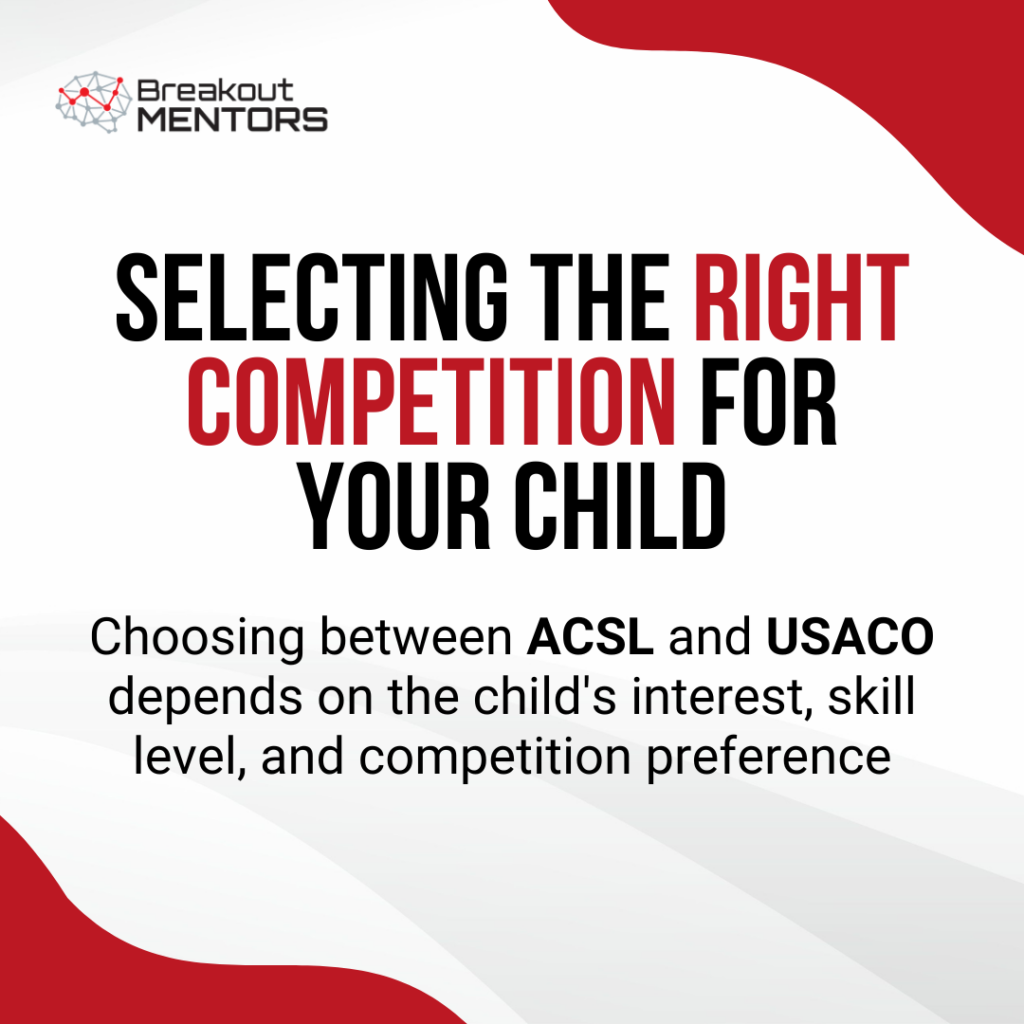The world of competitive programming provides an opportunity for young coders to showcase their skills. Think of it as a fun get together with similar kids across the country for an objective test of coding abilities.
Both the American Computer Science League (ACSL) and the USA Computing Olympiad (USACO) stand out as the best for middle school and high school students. Each has their own strengths and weaknesses, which we will explore in this article.
Choosing between ACSL and USACO comes down to understanding the nuances of each competition. ACSL is a team event that supports elementary and middle schoolers, while USACO is a solo contest exclusively for high schoolers. They both provide exciting puzzles to solve with code and a pathway to greater challenges, divisions, and impressive distinction. If your son or daughter enjoys competitive programming, it could be their chance to master advanced computer science skills well ahead of college. But which one should you choose: ACSL vs USACO?
What is Competitive Programming?
Competitive programming is when participants write code to solve algorithmic problems under time constraints. It’s not only a test of one’s coding abilities but also a platform for developing critical thinking, creativity, and persistence. For pre-college students, it provides a unique opportunity to delve into the world of programming and lays a strong foundation for future academic and professional endeavors.
What Type of Student is a Good Fit?
Students who thrive in competitive programming are those already familiar with coding basics and want to improve their skills. Typically a contest isn’t a great first coding experience. Most kids learn the fundamentals first through things like project-based learning and making video games. Then they set their sights on the challenge of competitive programming.
The kids who excel are the ones who enjoy puzzles. For example, solving a Sudoku puzzle. If your son or daughter is driven to improve their speed solving those puzzles and work on more difficult ones as they are ready, that same skill set can be applied to competitive programming.
There isn’t a set age, but we recommend elementary school students wait to try competitive programming. Middle school or high school students are an excellent age to give it a shot.
Introduction to ACSL and USACO
Both ACSL and USACO contests offer young coders a platform to engage in competitive programming. Let’s learn a little more about each of them.
The Fundamentals of American Computer Science League (ACSL)
The American Computer Science League (ACSL) is the world’s longest running computer science competition. Since 1978 they have offered contests and it has grown over the years to include multiple divisions. They are unique in offering some contests that don’t include writing code as well: think of it more as reasoning through problems.
The Essentials of the USA Computing Olympiad (USACO)
In the USA Computing Olympiad (USACO), participants solve complex algorithmic challenges as well. This competition was created to help identify and train for a prestigious US national team that competes in international contests! Of course most students don’t make it that far, but they run an extensive contest season that is open online to all participants.
Competitions Structure and Levels
Both ACSL and USACO provide structured competition levels to cater to students with varying degrees of experience in computer science.
ACSL: Starting from Elementary Division to Advanced
The American Computer Science League (ACSL) begins with specific divisions for elementary school students: Elementary and Classroom. These divisions don’t involve writing actual code, which makes it more approachable for beginners. This inclusive approach allows students to engage with computer science concepts and transition to coding as they are ready.
The Junior division is excellent for middle school students early in their coding education. This is the first competitive programming option for this age group, along with Liftoff Coders League. Then the Intermediate and Advanced divisions are for high school students.
USACO: From Bronze to US Team
USACO categorizes its participants into divisions Bronze, Silver, Gold, and Platinum. The contest was created to ultimately form the US Team, which represents the country in international competitions. So they also offer a prestigious invitation only camp for the top 30 competitors.
This progression system ensures that participants are constantly challenged and learning more advanced computer science as they are ready. However, even the Bronze division is very difficult, so high school students should have mastered coding fundamentals before joining USACO.
Contest Formats and Duration
ACSL’s 72-Hour Challenges vs. USACO’s 3-Hour Sprints
There is a notable difference in the duration between ACSL and USACO contests.
At the ACSL elementary school levels, the questions are short answer types, and the contest lasts only 50 minutes. For the divisions that include programming (Junior, Intermediate, Advanced), the ACSL contest includes 30 minutes of short answer problems and 72 hours for programming problems.
In contrast, USACO contests consist of three questions to be solved over 4 hours. The exception is the final contest of the year that is usually one hour longer since it is more difficult. This contest duration brings quite a bit more time pressure. You must be able to code efficiently and accurately after determining how to solve the problem.
Individual Competitions in USACO vs. Team-Based Contests in ACSL
ACSL is a team competition, although each student works individually instead of collaborating (with the exception of the Classroom division). Each school assembles teams of students for a given division, with the option for one or more teams, each comprising a maximum of 12 candidates. One intriguing aspect is that schools can opt for either a 3-score or a 5-score competition. The team’s overall score is determined by the sum of the individual scores of the top 3 or 5 contestants. So if they have a small or top-heavy team, they might opt for 3-score. But if they have a large team or want more kids’ scores to “count”, they might opt for 5-score.
USACO, on the other hand, is an entirely individual competition. You compete on your own from the comfort of your own home, at the time that works best for you. Every contest weekend runs from Friday to Monday. Your individual 4 hour timer only starts once you look at the problems. Since you don’t need to form a team or compete in-person, that makes USACO very easy to participate in.
Selecting the Right Competition for Your Child
The Best Ages for Each Contest
The ACSL and USACO contests cater to different age groups. Or more accurately, their strengths are for different age groups.
ACSL is the only option for elementary school children. It is also the most well known for middle school, although Liftoff Coders League is a new option that is easier to participate in. They also support advanced high schoolers, but aren’t as well known for it.
USACO primarily targets advanced high school students. The lowest division, Bronze, is quite difficult. However, it offers the ideal learning pathway for high achieving students.
How to Sign Up and Prepare for Each Competition
Preparing for ACSL: Team Joining Tips
For students looking to join the ACSL, forming or joining a team is a crucial first step. Often, schools will have existing teams, so interested students should reach out to teachers or club advisors for information. ACSL requires a registration fee of $150 for each team, with optional study materials to purchase, so the cost for joining teams will vary.
If your school does not have a team, you can either look for an after-school learning center or consider starting one with fellow students. We have an article that goes into this in more detail: ACSL Beginners Guide: How to Join a Team (Or Start Your Own).
USACO Preparation: Free to Join and Study Materials
USACO is free for all competitors. They also have some free resources on their website to learn the essential concepts and practice. However, for the best free study materials, I recommend looking at the USACO Guide website. It was created by a group of former competitors and is updated regularly as the contest evolves over the years.
These resources include detailed guides and past competition questions along with their corresponding solutions. However, the difficult part of performing well is realizing the right problem solving insight. This requires training your brain on the perfect difficulty practice problems and struggling through them, not just looking at solutions.
Obtain Expert Guidance and Tutoring
We have found 1-on-1 learning to be the fastest way to develop a student’s problem solving skills. Each student needs to work on the correct problems for them, not just work through a set curriculum. They need to be prodded in the right direction, not just given solutions. Then reinforcing the insights from that problem and how to recognize that pattern in future problems.
This is why Breakout Mentors has focused on 1-on-1 mentoring for competitive programming since 2019.
Frequently Asked Questions (FAQs)
How can my child determine which division to join in ACSL?
It is based on age and skill level. If they are in elementary school, you want either Elementary or Classroom. Find out what your school offers and talk to the teacher about which one they should join. Middle school students who can code a little already should do the Junior division. And very strong coders who have already competed before should do Intermediate. We have an article ACSL Competition: A Comprehensive Breakdown of the Divisions and Practice Problems that goes into this in greater detail.
Are there any location restrictions for competitors?
One of the great aspects of both ACSL and USACO contests is their accessibility. There are no geographic restrictions for participants. Students from anywhere in the world can compete, provided they have internet access and meet the competition’s age and skill level requirements.
Yes, even though it is called the United States Computer Olympiad, international students can participate as well. However, should they reach Platinum, they aren’t eligible to make the US Camp or US Team.
What Are the Best Ways to Prepare for These Competitions?
It is tough to generalize the best way to prepare across all ACSL and USACO divisions. The best approach is specific to the student’s individual knowledge. One effective approach to education is to learn from someone who has recently been through the same learning journey. This means older kids who did ACSL or a USACO tutor who is now in college. They will be able to provide specific guidance to your unique situation.
Get Started, Have Fun, Keep Going!
Choosing the right competition is crucial for keeping a student engaged without feeling overwhelmed. They should enjoy the journey of learning computer programming, not just focus on the end results.
We hope this article helped you understand the strengths and weaknesses of both ACSL and USACO. Both are excellent choices. The key is to dive in, enjoy the puzzles and problem solving, and remember that every coder’s journey is unique — filled with learning, challenges, and ultimately, a lot of fun.
